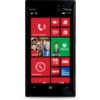Nokia Lumia 928 User Guide - Page 64
Additional safety information, Make an emergency call, Small children, Medical devices, Implanted - skin
 |
View all Nokia Lumia 928 manuals
Add to My Manuals
Save this manual to your list of manuals |
Page 64 highlights
Nokia Lumia 928: Safety and Warranty Do not dismantle, cut, crush, bend, puncture, or otherwise damage the battery in any way. If a battery leaks, do not let liquid touch skin or eyes. If this happens, immediately flush the affected areas with water, or seek medical help. Do not modify, attempt to insert foreign objects into the battery, or immerse or expose it to water or other liquids. Batteries may explode if damaged. Use the battery and charger for their intended purposes only. Improper use, or use of unapproved or incompatible batteries or chargers may present a risk of fire, explosion, or other hazard, and may invalidate any approval or warranty. If you believe the battery or charger is damaged, take it to a service centre before continuing to use it. Never use a damaged battery or charger. Only use the charger indoors. Additional safety information Make an emergency call 1. Make sure the phone is switched on. 2. Check for adequate signal strength. You may also need to do the following: • Insert a SIM card. • Deactivate call restrictions you have activated for your phone, such as call barring, fixed dialling, or closed user group. • Make sure airplane mode is not switched on. • If the phone screen and keys are locked, unlock them. 3. Press . 4. Tap . 5. Tap Enter the official emergency number for your present location. Emergency call numbers vary by location. 6. Tap call. Give the necessary information as accurately as possible. Do not end the call until given permission to do so. Important: Activate both cellular and internet calls, if your phone supports internet calls. The phone may attempt to make emergency calls both through cellular networks and through your internet call service provider. Connections in all conditions cannot be guaranteed. Never rely solely on any wireless phone for essential communications like medical emergencies. Small children Your device and its accessories are not toys. They may contain small parts. Keep them out of the reach of small children. Medical devices Operation of radio transmitting equipment, including wireless phones, may interfere with the function of inadequately protected medical devices. Consult a physician or the manufacturer of the medical device to determine whether they are adequately shielded from external radio frequency energy. Implanted medical devices Manufacturers of medical devices recommend a minimum separation of 15.3 centimeters (6 inches) between a wireless device and an implanted medical device, such as a pacemaker or implanted cardioverter defibrillator, to avoid potential interference with the medical device. Persons who have such devices should: • Always keep the wireless device more than 15.3 centimeters (6 inches) from the medical device. • Not carry the wireless device in a breast pocket. • Hold the wireless device to the ear opposite the medical device. • Turn the wireless device off if there is any reason to suspect that interference is taking place. Chapter 18 63















